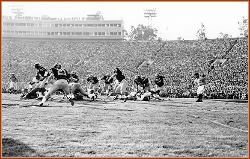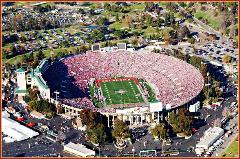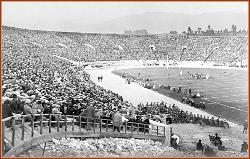Hearing those words from public address announcer Dan Borne' as the Tigers enter
the stadium brings chills to even the casual LSU football fan and sends shivers to
those on the opposing sidelines. Seven nights a year (eight in 2006), Tiger Stadium
becomes the sixth largest city in the state of Louisiana as over 92,000 fans pack the
cathedral of college football to watch the Tigers play.
For LSU fans, there's nothing better than spending a night in Tiger Stadium. LSU
home football games are events talked about year round and happenings in Tiger
Stadium are passed down from generation to generation.
For opponents, however, it's another story as Tiger Stadium is an intimidating venue
that has been called one of the most dreaded road playing sites in all of college
football. Seating over 92,000 fans and nicknamed "Death Valley," poll after poll have
proclaimed Tiger Stadium as one of the greatest sites anywhere for a college football
game.
History
The home of one of football's proudest traditions, Tiger Stadium once served as a
dormitory for approximately 1,500 students, and while Broussard Hall, then LSU's
athletics dormitory, was being renovated during the fall of 1986, the LSU football
players lived in Tiger Stadium.
The original phase of construction was completed in 1924. This first phase included
the east and west stands, which seated about 12,000. Seven years later (1931), the
sides were extended upward to accommodate an additional 10,000 fans, raising the
capacity to 22,000. In 1936, the stadium seating capacity was increased to 46,000,
with the addition of 24,000 seats in the north end, making Tiger Stadium into a
horseshoe configuration.
The next phase of construction took place in 1953 when the stadium's south end was
closed to turn the horseshoe into a bowl, increasing the seating capacity to 67,720.
The upper deck atop the west stands was completed in 1978, and it added 8,000
seats to the stadium's capacity. Additional seating in two club level sections which
flanked the existing press box brought the total addition to approximately 10,000
seats and raised the stadium's capacity to approximately 78,000.
Refurbishing began on the stadium in the summer of 1985, when the east and west
stands were waterproofed, and 25,000 chair back seats were added to replace the
older "bench" type seats. Another phase of improvements was completed in 1987,
when the north and south stands were waterproofed and newer bleachers were once
again installed to replace the older ones.
The playing field was moved 11 feet to the south in 1986, to provide more room
between the back line of the North End Zone and the curvature of the stadium fence,
which surrounds the field. It also put the playing area in the exact center of the
arena's grassy surface.
The Tiger Stadium press box was redecorated prior to the 1987 season, and a few
more seats were installed at the upper portion of the west lower stands. Also, the
stadium's seating arrangement was renumbered prior to the 1987 season to make all
seats a uniform size. The addition of bleacher seating in 1988 brought the capacity to
80,150 and the elimination of some bleacher seating after the 1994 season to
accommodate renovated visiting team dressing facilities, and other ensuing seating
adjustments, brought the capacity to 80,000.
Now the sixth largest on-campus stadium in college football, Tiger Stadium continues
to expand. Five years ago, 11,600 seats were added with the installation of the east
upper deck to bring the capacity to 91,600. In addition to the new east upper deck, 70
skyboxes, called "Tiger Dens", were built, giving Tiger fans luxury accommodations.
The addition of the 11,600 seats in 2000 marked the first expansion to Tiger Stadium
since 1978, when the original west upper deck was completed









Notable Facts
Tiger Stadium is one of only three Division I-A schools
that still use the classic double-posted goal posts. They
received special permission from the NCAA prior to the
November 20, 2003 game against Tulane in conjunction
with LSU's football centennial. These goal posts
remained intact for the 4 New Orleans Saints games
held in 2005, with special permission from the NFL.
Under NFL rules in place since 1967, goalposts for NFL
games must be "slingshot" style with a single post and
bright gold in color. Tiger Stadium's goalposts are
white. The only other I-A stadiums that use goalposts
with two posts are Doak Campbell Stadium at Florida
State and Martin Stadium at Washington State.













